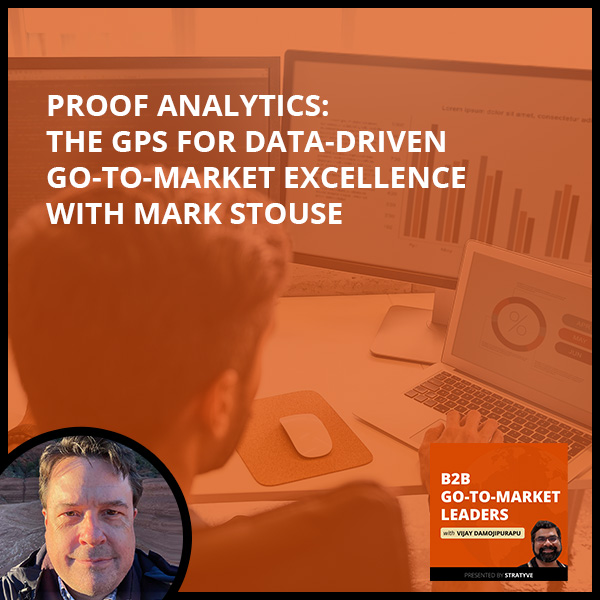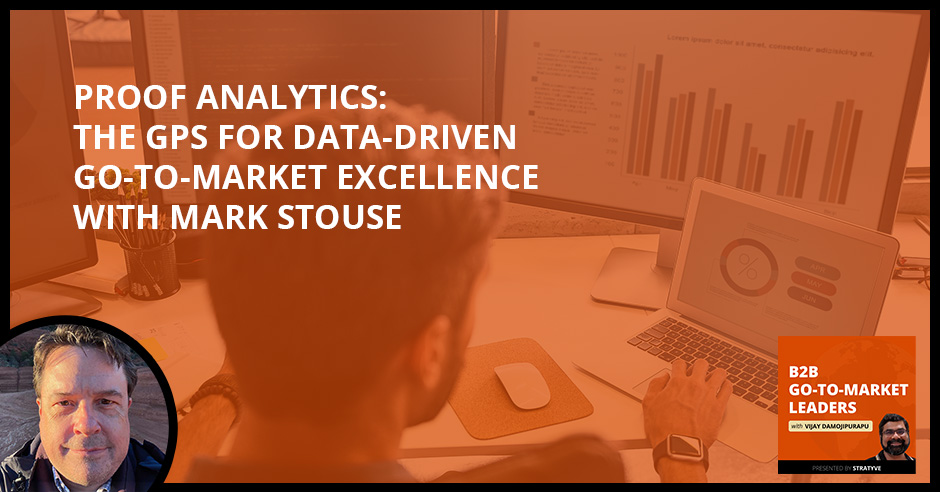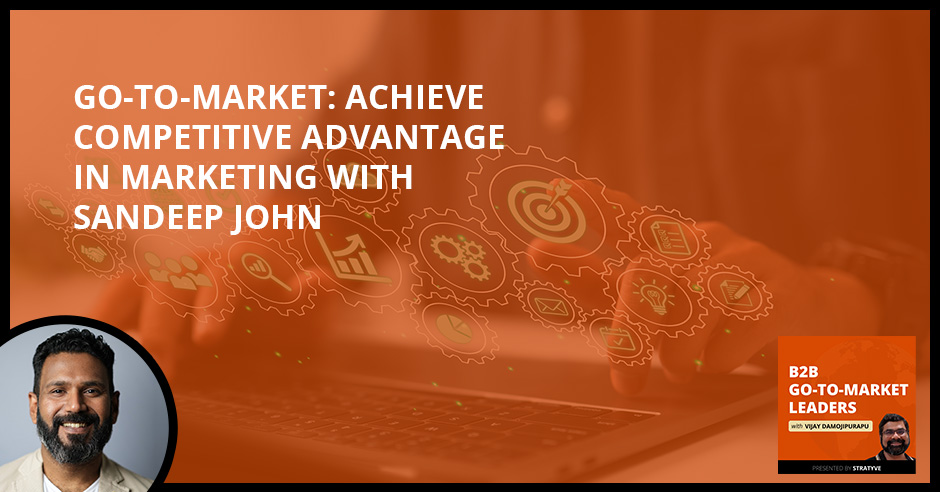

Proof isn’t just about data – it’s about unlocking the potential within every decision. Harness the power of data-driven navigation and make your go-to-market journey a triumph of strategy and success. In this illuminating discussion, we sit down with Mark Stouse, the visionary founder of Proof Analytics, a groundbreaking analytics solution that’s revolutionizing the way businesses approach marketing performance. Mark shares the trials and triumphs of building Proof, detailing the meticulous process of finding the right market fit and fine-tuning its offerings. He also highlights the power of iteration and feedback loops to the success of the product’s direction. From identifying the Ideal Customer Profile (ICP), embracing the feedback wave, and predicting the future of analytics, Mark reveals plenty of wisdom and strategies in the episode. Tune in now to explore the wonders of Proof and understand how to navigate success!
—
Listen to the podcast here
Proof Analytics: The GPS For Data-Driven Go-To-Market Excellence With Mark Stouse
Thank you for taking the time to tune into yet another and the newest episode of the show. I have the pleasure of hosting Mark Stouse who is the CEO of ProofAnalytics.ai. I’m excited and I look forward to the conversation. Welcome, Mark, to the show.
I’m glad to be here. Thank you so much for having me.
Let’s get right into the meat of the conversation. How do you view and define go-to-market?
I had that question in a customer demo call. It’s a highly situational thing but a definition that works for almost every situation is this. Any part of your business that is customer-facing that has a provable substantiated role in whether or not someone does business with you and continues to do business with you is go-to-market. For example, we have a couple of customers like this that include customer experience with accounts receivable, contracting, and things like that.
In go-to-market, that’s a pretty rational decision because both of those areas can piss off somebody. It has nothing to do with product sales and marketing. The only way you find out about it is if someone says something to a customer success person but that presumes that you have a customer success team that’s engaged and has relationships with your customers. That’s the way I would answer that. I don’t think it’s the classic or the big four in sales, marketing, customer success, and products but I do think that we don’t get to define it. Our customers define it. It’s like a brand in that sense.
You are probably one of the fewest or the first guests on this show who has expanded the scope of go-to-market beyond the big four within a company. Something that caught my attention is when you mentioned a team or a function like accounts receivable that can have an impact on go-to-market. Do you know of any stories where a customer stopped buying a product or a service because of a bad account receivable experience?
I can share one firsthand inverted. Some years ago, we had a very large multinational that treated us as though we were a bank for them. They were paying our invoices somewhere between net 120 and net 150 no matter what the conversations were. They had an outsourced relationship with their accounts payable team. It was outsourced. In their contract with our mutual customer, they were incented in various ways to hold onto cash. They went way beyond, and because we couldn’t get any satisfactory resolution, we fired our customer. We said, “Under these circumstances, we can’t do business with you. We’re not going to renew the software contract.”
I like how we got started on this conversation and the definition of go-to-market. Let’s expand and then shift gears here. Why don’t you tell our audiences about your career story and your journey without spending too much time? You had an expansive career. What led you to what you’re doing now and who you serve?
The most important thing that I could say about myself or the most relevant thing is I have been an operational executive for a long time for big companies where I was either in the C-Suite or one down or reported to someone in the C-Suite. As a marketer, I was like everybody else. I was always under the gun for proof of impact, ROI, and all this stuff. Years ago, at HP working for Mark Hurd, it got intense both for me and my peers because Mark was not going to have it.
I had to make a choice between whether I was going to remain at HP maybe even as a marketer or do something to fix it. I had a conversation with him and the CFO of HP at that time. I came away with some very clear expectations and then started getting reacquainted with a lot of the principles that we all study in high school and university math. Regression is a big one.
I started on that journey. By the time 2008 to 2010 rolled around, my teams more importantly than me had gotten to a place of strong maturity on this journey. Ultimately, I was recruited into Honeywell Aerospace pretty much on the basis of that work being able to tie the non-linear marketing multiplier into impact on linear sales productivity, net of time lag, and net of multi-variable type of stuff. Honeywell was the ultimate large-scale POC but the problem was because we were very successful in terms of the mission.
People always say, “How do you define success?” Does the business believe you? Does the board believe you? Do they make business decisions based on your analytics? That’s success. Transforming a functional marketing conversation into a business strategy conversation is what it’s all about. By that measure, we’re very successful but it was still a brute-force solution. We were having to spend $8 million or $9 million a year hiring loads of data scientists because the key part was we had to get the latency on the calculation down so that it was relevant. This whole deal of recalculating big models twice a year or once a year is ridiculous. There are not a lot of companies that are willing to spend that kind of money. It was obvious that automation was going to be a big next step.
A bunch of things came together for me personally, and I stepped out of Honeywell and did an interim privatization role at BMC where the analytics was super important not only to the company but to the PE firms that we were taking as private. Based on all that, I then formed Proof, and we started building the platform. It’s part of a rapidly expanding category that includes companies like Google and Meta. There are a lot of different variations on a common theme here.
COVID and the ramifications of COVID poured a lot of gasoline on it. The deterioration of the macro environment poured a lot of gas on it. Nothing makes people want to look further down the road and around corners like bad situations. Real forecasting, marketing, impact on sales, sales velocity, recruiting and retention, or whatever is important to the business has spiked.
Nothing makes people want to look further down the road and around corners like bad situations. Share on X
One of the huge ironies seen in the analytics is that if you wanted to depict a common corporate function marketing, that should not ever be in doubt about its ROI. Marketing is it because the same dollars drive so much value in so many different directions and aspects of the business that you cannot lose. At any given time, 20% of your marketing spend is some speculative thing that you’re testing. A lot of times, it doesn’t work. You lose that money but if everything else is performing so well typically in so many different areas of the business, you can’t lose.
That’s pretty impressive, especially the anecdote that you shared where the great late Mark Hurd pushed you on talking about the numbers and whether it’s working or not in whatever you’re doing in the marketing or corporate communication space. That’s a great eye-opener. If I were in your shoes, my first reaction would be, “Am I screwing it up big time?” We get over it and then let’s figure out how to make this happen.
It also shows you how much has changed in the workplace. Mark was a very intense physical person, and he did not acknowledge the idea of personal space. When you say, “Pushed,” he didn’t put his hand on me and pushed me but he got so close to my face that I had no option but to step back and then hit the wall behind me. I was trapped. He did not care how I felt about that. That would not fly in a lot of companies, even at HP. No one thought anything about it.
That’s connecting the dots on your career journey. What led you to what you’re doing with Proof Analytics? I’m looking at your website. You have big names pretty much throughout. You’ve got Dell. You mentioned AWS, Google, and Salesforce. What is a common driving factor as to why they’re buying your product?
That has changed in 2022. As probably most marketers have already experienced to their chagrin and pain, finance is in charge. There are large budget cuts and large people cuts, even the money that’s left behind as a budget. There are a lot of finance oversights and approvals on spend. There’s a lot of lost autonomy over people’s money. The third leg of this is that cheap money is gone. The money that they do have to spend is prized even more than it ever was because it’s so hard to replace. The opportunity cost of the money is more significant.
It’s happening now and it is accelerating rapidly. FP&A or Financial Planning and Analytics teams are taking over accountability and optimization for go-to-market and a lot of other functions that have nothing to do with go-to-market. The general feeling is that marketing in particular has had lots of time to get a handle on this. For a variety of reasons like lack of capability, lack of capacity, lack of desire, and some combination of the three, they’re not doing it. We have seen that.
Historically, with Proof, we cater to true believers who know that it’s real and want to go on that journey or hyper-mature companies and marketing teams that have been doing this for a long time the old-fashioned way and want a better, faster, and cheaper alternative to doing it. More and more what we’re seeing is the pipe is dominated by finance.
The deals and the increasing number of economic buyers are finance. Even if the name on the contract is the CMO, it’s dictated by finance. It is run by finance. The proof is increasingly run as a piece of software by finance teams in collaboration with marketing, sales, and other stuff but it’s not peer-to-peer or equal-to-equal. It’s first among equals. That’s a big change. I don’t think that’s going to stop anytime soon. For example, I’m not trying to say that it’s all one reason but money would have to get a lot cheaper and a lot more accessible for that to be relaxed.
That’s going to be some time. What we experienced cheap money at 2% or even less for the last almost decade is going to be some time away. There’s going to be a driving need for you.
An optimistic projection on that is 5 to 10 years. Depending on stuff that no one can forecast, it could easily be 10 to 20.
We’re switching gears here. I was not planning to ask this but based on your story and your background, I wanted to dig a little bit into what led you to build a founding team and the early days of Proof. Can you share about the early days of Proof? How do you test the concept and your co-founder, if you have co-founders or not? How do you do that?
This is not something that you can do by yourself. Number one, we were very averse to hard-won experiences earlier in our careers and VC money. We went after a limited amount of family office money plus bootstrapping. That fundamental parameter dictated some other things that go to your question. We needed people who were experienced, who preferably had already made a lot of money in their careers one way or another, and who at least in the early days did not require any cash compensation for full-time effort.
This was before it all became fashionable and then controversial. We were remote from day one. We prioritized talent, meaning the people, over the location. That was pivotal in retrospect to being able to do this. Particularly when you consider the fact that, unlike a lot of SaaS where you can get away with a true MVP and then scale it, in analytics, you’re either complete or you’re incomplete. If you’re incomplete, no one cares.
We had to build a back end. In a sense, our MVP was our back end, which had complete analytical capability because there weren’t a whole lot of surprises there. It is what it is. The wildcard was the UX and not the UI although that was super critical too. We raised money off the back-end capability or the technical capability and then started to do focus groups and a lot of other things to figure out what the UI and the UX needed to be.
Interestingly enough, it was supported by a lot of other things but the in-the-moment big epiphany was with a large retail customer. They were using daily data in the models and on some models, hourly data. The automatic recalculation of the models was now so fast. The latency was so low that you could see it operating. What jumped off the page or the screen was a GPS. It was working exactly like the GPS on your phone.
That took us into a certain perspective, and now I’m even more convinced of it years later. Almost every question you have in business, and you could even say it about life, is a navigation question. It’s a GPS question, “How am I doing against what I think is my goal? What are the things that are screwing me up or speeding me up? If something changes, what do I do? Do I turn right or left?”

In the movie Lincoln, there’s a great scene where one of his political opponents is saying that the moral compass regarding slavery had ossified in White American men and women. It’s a very powerful and undeniably true statement. Lincoln said, “I agree but as a former surveyor, I can tell you that as important as it is to know True North. The compass tells you nothing about all the swamps, barriers, and mountain ranges in your path.” If all you’ve got is True North, what’s the value of knowing True North? You have to know the rest of it too.
In many ways, that is Proof. That’s what a GPS does for you. It’s tracking your progress along a particular forecasted route. It’s also tracking all these other factors that you can’t see. You may know that they’re important but you can’t see them until it’s too late. It’s saying, “There are lots of traffic ahead. This was a good way to go. Now it’s not a good way to go so let’s reroute you over here.” That’s exactly what Proof does. It lets you know the most important factors.
Going back to that retail customer, it sounded like that was your first pilot and proof that there are legs to what you are working on.
It wasn’t our first pilot in the overall sense but it was the one that gave us the epiphany on how to think about the UI because one of the problems is that business and marketing people specifically seem to have an allergy to math in general and graphs in particular. If all you’re doing is giving them a beautiful visualization of data science output, you’re not going to get what you want. It’s not going to help them. It needs to help them. We had to interpret the analytics through the lens of a GPS, and that made a huge difference. That’s where UI and UX fused and became one and the same.

Did you have a strong UI-UX person in your co-founding team? Did you have to bring in someone from outside?
We had some pretty strong players but everybody agreed that we wanted somebody so good that we could not afford to hire them as an employee or even as a permanent contractor. We could just hire them on a project basis. That’s what we did. It was fantastic. It was great. It’s hard to say personally whether I’ve learned more about go-to-market than I ever knew before as a result of running Proof, or I learned more about business decisions as a result of running Proof.
Especially in the early days, you need to figure out your own go-to-market. It’s almost like Meta. If you are serving go-to-market teams, you need to figure out your go-to-market while you’re helping them figure out their go-to-market better.
Fortunately, if you’re sitting in our position, you can learn a lot of lessons from your customers. In our particular case, we can’t see their analytics or their data unless they click a magic button to give us that ability. Most of the time, they don’t, and that’s fine but invariably, we get into conversations where even if they don’t give us permanent access, they give us a few days of access because they need our opinion on something. You learn a ton. It’s like being in a giant focus group.
Proof was founded in 2015 and here we are in 2023. What financial details can you share in terms of number of customers, employees, and revenue ballpark?
We were not in the market that long. We have only been in the market for a few years because all the rest of it was development. You only know this in retrospect but the marketplace wasn’t ready for it yet. The timing wasn’t right, looking back on it. That worked in our favor because it gave us the time to build. No one else was being encouraged by demand signals from the marketplace to build something competitive for us at the time.
When we entered the market, we had a pretty significant advantage. That category has now been validated by Meta, Google, and Apple. There are a lot of offerings in the space now. They’re beautiful products but they tend to be far more technical or data sciencey. Ours is a bridge between those two. We will probably finish this fiscal year in excess of $3 million ARR. All the normal caveats apply to that. That is probably 30 or 40 customers but that’s the other wild card on this thing.
What we have seen in 2022 is significantly different than any other year before. Doing a year-over-year comparison without a lot of explanatory information is not even possible. Our pipe is probably in the vicinity of $15 million to $20 million. We have two different products. We have the analytics product and we also have the only MRM tool that’s native to Salesforce.
That’s very popular but they have two completely different sales motions, ACVs, and all that stuff. We run them effectively as two licensed trading companies, which some might call subsidiaries. In this case, it’s not but it’s the same idea. You have to take that all. Lord-willing and the creek don’t rise, as they say in Texas, and from my lips to God’s ears, we could be substantially higher.
Thank you for sharing the founding story. That’s something intriguing and interesting to a lot of the audiences. The idea of founding a company is as exciting as it may sound and be but building a company is a whole different ballgame. That’s why I was pushing you and trying to extract those points around that.
I’ll add one more thing that is so important. Defining your ICP correctly is huge. Its impact is huge. One of the reasons why we have grown more slowly than some people might have expected is that we defined our ICP so tightly. We did not want to have a lot of churn. We were aiming for no churn. We were very picky for the past few years about who became a customer. Everything is cause and effect-related. You make that choice. You are probably going to grow more slowly at least for a period but that has been great for us because the learnings are not achieved without customer input. We were able to do it in a more methodical way and a less freaked-out way. That has been super valuable.

It’s interesting you say that ICP is supercritical. I was talking to another member of my team about how we had to evolve our ICP. It’s all ICP. I was talking to another guest who was leading marketing at a fast–growing Series A funded by Sequoia. He was talking about the importance of ICP. ICP is super critical for sure. You did touch upon that earlier about how you have evolved the ICP or how your ICP has evolved due to the market conditions. Earlier, it was mostly the CMOs but now, it’s more on the CFO’s side of the house.
It’s mainly finance as opposed to ops but it can be both. There’s a level of urgency in the business around accountability and optimization that is driving these changes. The revolution that we’re seeing is being generated from the top, not from the bottom. Like every revolution in history, it’s going to have its excesses. There are going to have to be course corrections. As sure as God made little green apples, people are going to overcut. They’re going to cut too deep and do crazy stuff that then will have to be walked back. That’s the way it goes.
One of the ways though that we are trying to help people is to say, “If you use Proof or for that matter something similar to Proof, you will break less glass, or you will break pretty much only the glass that makes sense to break.” That is something that we see resonating with everyone, not just finance or the functions. They are both concerned about that but probably for very different reasons. That’s where it is.
For example, a great subset of this is MarTech stacks or tech stacks in general. The MarTech stacks are being winnowed at a tremendous rate. Being able to figure out what you can dispense without breaking the whole thing is super key. It’s not a new criteria. It’s just that people have suddenly become switched on about it. If you have bought technology and you don’t have the team in place to extract a lot of value from the technology, they will whack it. No questions asked. That’s new. Historically, when money was a lot cheaper, you would buy the tech and then get the recs approved to hire the team to run the tech but that would take you a year all in. Your first year on the tech was valueless. They’re not prepared to entertain that anymore.
There are two things that are of real interest to the audiences of the show. One is a go-to-market success story, and on the flip side, a go-to-market failure story. Pick yours. You can go with either one first, and you can either talk about Proof’s success or failure or a client of yours.
I’ll talk about it in terms of a failure, specifically my failure. A lot of founders go through this but I’m going to say that I went through it. I tended to think at the very beginning that I was not an outlier and that I was more representative than not of the ICP. I was so wrong. In the beginning, we had some great customers who didn’t pay us much in money but paid us a lot in feedback and all that stuff. What you kept on hearing again and again on real sales calls was, “This is the future,” which in the beginning, you take as extreme validation until a sales guy one time reinterpreted that for me and said, “What that means is not now.”
It’s in the future, not now.
Technically, it took a while to get it all straight because it took a while for all of us to get the go-to-market. What I will say to audiences who are in the middle of a similar experience is this. The temptation is to believe that somehow you got something structurally wrong and that you need to shut it down. The odds are very low that’s true. You just haven’t found the point or the use case at which enough people to make the business viable can see the value.
The temptation is to believe that somehow you got something structurally wrong and then you just basically need to shut it down; the odds are very low that that's true. Share on X
You wanted X to be a use case. You need to be willing to let go of that and let customers and prospects tell you what the use case might be. Classically speaking with customers that use the software, the failures are almost always not about execution. They are about something far more fundamental. Your perspective was off. It’s not dissimilar to my problem. What you thought was important isn’t. You forget that it’s a maxim in analytics and data science. Two-thirds of every model should be stuff you don’t control.
Our bias in the most fundamental sense is what we do matters. I have a news flash for you. You are trying to surf a wave that is every bit of 60% to 65% of the equation. You will never control the wave, whether you wipe out or finish with a flourish on the beach is related to your skill. That would be execution, the feedback loops that you build between yourself, and your board in the wave that allow you to anticipate what’s going on to react more appropriately to what’s going on in the wave and not wipe out. That’s it, but if you don’t have the feedback loops and you, for whatever reason, aren’t acknowledging the importance and the centrality of the wave, you’re going to have a big problem.
We had a customer who had an uber-creative marketing team that was creating campaigns that were cool but fundamentally irrelevant to the business and spending hundreds of millions of dollars to do so. If you’re the CFO, you’re like, “What could I have used that money for? Even if I had let that money fall to my bottom line and give it to the street as EPS, that would have been huge.”
This is the inextricable relationship between success and failure because when you recognize the failure and the wrong direction, you move in the right direction. Over time, it’s a huge success. You’re wiping out the negative and embracing, obtaining, and earning a whole level of positivity. A classic is we go in and sell the software. They implement the software. The first 1 or 2 cranks on the models typically show that 20% to 25% of marketing spend is performing suboptimally or not at all.
A lot of people tend to see that purely from a position of ego and thus judge in black robes saying, “You screwed up.” It’s a coach that says, “I’m coming in. I’ve seen this many times before. I’m going to save you a lot of time here and whack this stuff.” You go from 28% suboptimized spend to realistically 2% to 3% suboptimized spend. You do that very quickly and reallocate that money into areas that are winning.
Since you’re running an S-curve or an optimization curve, you know that you’re also not past the point of diminishing returns. It’s a net plus. That’s a huge win. That’s the way I would describe this. Going back to the GPS thing. By using the GPS, you cannot be an hour late for your business dinner but only be eight minutes late with an explanation for that. How is that not a win? That’s a huge win.
We are coming up against time over here. Our final question for you is this. If you were to turn back the clock, what advice would you give to your younger self?
How far back? How young?
Day one of your go-to-market journey. How about that?
It’s almost like a Law of Nature. The thing that scares you the most or that you dislike the most is very likely to be super important to your life and your success. I had the opportunity to go back to my high school not too long ago. She was super close to retirement now and all that stuff. I ran into my Math teacher. When I told her what I was doing now, you could tell that she didn’t know what to do with that because I was not a Math guy in high school. I was an English guy, a Literature guy, and a creative writing guy. I was all that. I made no secret of my distaste but it was fear of looking stupid in Math class.
When I went on this journey with Mark Hurd for a while, I got ahold of a Math tutor. Every single Math teacher anywhere should teach Math like this guy taught Math. He changed me. It was like going to psychotherapy as much as it was Math class. I would encourage you to confront your fears, your dislikes, or whatever word you want to put on them. Confront them transparently, voluntarily, and openly.
Confront your fears, your dislikes, or whatever word you want to put on them. Confront them transparently, voluntarily, and openly. Share on X
In another different area, I had a fear of heights when I was younger. When I was in my mid-twenties, I was dating a girl. She was a nurse who did pararescue. She would jump out of airplanes and things like that. I wasn’t about to look like an idiot. When she asked me to do a tandem jump with her, I did what probably 99% of all males would do. I jumped and discovered that I liked it a lot. I continued to do it for a period but what’s interesting, and I was never able to get past this one, is that if you asked me to do the same thing from a stationary platform or a cliff for what’s called base jumping, I cannot do it. I have not ever been successful in getting past it. I share that as well because I have the same limitations.
Those are great conversations and great insights. Thank you for your time, Mark. I wish you and the Proof team the very best.
Thanks so much.
Important Link
Love the show? Subscribe, rate, review, and share! http://stratyve.com/






